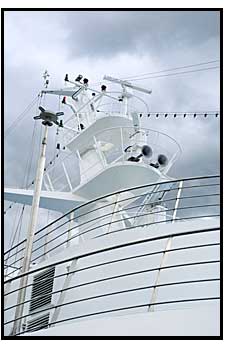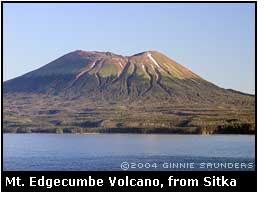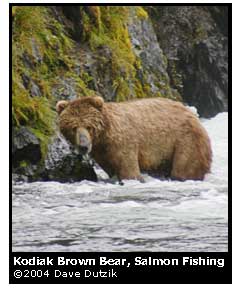|
June 30, 2004 – My
husband and I are spending most of the summer touring
East Asia with the Semester At Sea program. From
June 17 to August 21 we will travel over 12,000 miles with many
stops along the way. (See last week.)
Semester At Sea (SAS) is an educational program administered by the
Institute
for Shipboard Education (ISE) and sponsored by the University of Pittsburgh. It
offers college students a fully accredited academic term of international
shipboard study and travel. Faculty, staff and students come together
from diverse cultural
and academic backgrounds to live on a large ship as it travels around
the world. It
offers college students a fully accredited academic term of international
shipboard study and travel. Faculty, staff and students come together
from diverse cultural
and academic backgrounds to live on a large ship as it travels around
the world.  Courses
are offered in a wide range of subjects, including anthropology, engineering,
art, english, history, communications, music, political science, law,
religion, biology, sociology, geology, oceanography and business.
Academic credits for shipboard courses are equal to credits for the
same courses at the University of Pittsburgh; as such, they are transferable
to most other institutions. A majority
of the SAS students are undergraduates, but special programs are available
for engineering and law students on selected voyages, and for
teachers (K-12) who are seeking continuing education credits. A limited
number of spaces are also available for adult passengers who wish
to experience foreign travel in a unique academic environment. Courses
are offered in a wide range of subjects, including anthropology, engineering,
art, english, history, communications, music, political science, law,
religion, biology, sociology, geology, oceanography and business.
Academic credits for shipboard courses are equal to credits for the
same courses at the University of Pittsburgh; as such, they are transferable
to most other institutions. A majority
of the SAS students are undergraduates, but special programs are available
for engineering and law students on selected voyages, and for
teachers (K-12) who are seeking continuing education credits. A limited
number of spaces are also available for adult passengers who wish
to experience foreign travel in a unique academic environment.
About our Voyage
We boarded the Explorer in Portland, Oregon, on June 13, along with
other incoming faculty and staff. The next morning our ship left port
and
headed to Vancouver, Canada. We arrived there a day later. We spent
two days in port while the students boarded the ship and settled in.
(I loved
Vancouver!) On June 17, at 5pm, the Explorer departed for for Sitka,
Alaska. Not long after we were underway, an "abandon ship" drill
was called. It was pretty interesting, but I suspect the life boat
drills will
seem increasingly dull
as we repeat them time and again. That evening, after dinner, we attended
an orientation meeting – required for all passengers.
The next full
day
was spent at sea. A series of mandatory classes were held to introduce
everyone to Alaska and its history. That night a general pre-port meeting
was called
(also mandatory) to cover details of our port call in Sitka.
When we are at sea, classes
are held every day. When we are in port, students and faculty take
part in a variety of elective educational field programs which must
be reserved and paid for in advance. Students are not required to
participate in these educational field trips, although they are encouraged
to do so.
Most sign up for a few programs at each port, and then go exploring
during their free time.
 Sitka Sitka
We arrived in Sitka on June 19
and anchored for two days. We were transported to shore via the
ship's tenders (small boats) which ran to and from the ship at regular
intervals. On shore, sponsored field trips included a marine wildlife
tour via jet boat, a hike in the Tongass National Forest, a walking
tour of Sitka, salmon and halibut sport fishing, a Russian America
and nature tour, and an extended bike and hike tour of the Alaskan
countryside.
We opted for the jet boat tour. Oddly enough, Sitka was experiencing
record breaking heat while we were there, and the poor Sitkans were
sweltering. We were, too.
According to a life-long resident, Sitka usually gets only one
or two days between 70° and 75° each summer. Those are considered
the "dog days"
of summer. On June 19, the day we landed, it was already 82° at
the Crescent Harbor city dock by 11am. By mid-afternoon it was 85°,
about 30 degrees higher than normal. Many of the small downtown shops
were shuttered and closed. It was simply
too hot to work indoors (no air conditioning) and most Sitkans – those
who could, at least – headed
to the water where it was cooler.  After
touring the city with a stop at the Sheldon
Jackson Museum,
which we very much enjoyed, we too headed for the water. It was time
for our jet boat tour of Sitka Sound. For the next three hours we,
along with 45 other SAS participants, enjoyed a 50 mile round-trip
wildlife tour of Sitka Sound.
We saw bald eagles, humpback whales, a raft of floating sea otters
and scores of Steller sea lions basking on a rocky outcrop. In addition
to the wildlife, I was able to get some good clear shots
of the dormant cinder cone of Mt. Edgecumbe volcano (3201 feet, 976
meters), one of the most distinctive geological features of the area.
When the tour was over, we were deposited back at the wharf, smiling
and sunburned. After
touring the city with a stop at the Sheldon
Jackson Museum,
which we very much enjoyed, we too headed for the water. It was time
for our jet boat tour of Sitka Sound. For the next three hours we,
along with 45 other SAS participants, enjoyed a 50 mile round-trip
wildlife tour of Sitka Sound.
We saw bald eagles, humpback whales, a raft of floating sea otters
and scores of Steller sea lions basking on a rocky outcrop. In addition
to the wildlife, I was able to get some good clear shots
of the dormant cinder cone of Mt. Edgecumbe volcano (3201 feet, 976
meters), one of the most distinctive geological features of the area.
When the tour was over, we were deposited back at the wharf, smiling
and sunburned.
The next day was even hotter.
It hit 90 degrees. Many of the students were sunburned from the
day before, but that didn't slow them down. Some even went swimming
in Crescent Harbor off the city
dock. Due to high demand, we weren't able to get spaces in our requested
field trips,
but that didn't matter to us. We took off on
our own to further explore the area. As American bald eagles soared
overhead in the deep blue sky, we headed for the Alaska Raptor Center.
Later we made our way to the Southeast Alaska Indian Cultural Center
where we saw numerous totem poles displayed along the park's two miles
of woodland trails. We ended our visit Sitka with a tour of St.
Michael's Russian Orthodox Cathedral in downtown Sitka.
 Kodiak Kodiak
Our next stop was Kodiak, a small
Alaskan town (population ~6300) located on the
island of Kodiak. Most Alaskans refer to this region as "Bush
Alaska," not
because the residents support George W, but because the area is much
closer
to wilderness than to civilization.
After another
full day of classes at
sea, the Explorer reached the Kodiak
pier early in the morning on June 22. We were
scheduled to leave again that night, so everyone had just one day to
enjoy the rich natural beauty of the area. The weather was much cooler
in Kodiak, and I think everyone was grateful for that.
Elective field trips included a city orientation followed by a Russian
Tea,
Kodiak
brown
bear viewing
by floatplane, halibut sport fishing, a rainforest botany hike, and
a tour
of the Alutiiq Museum. Again, due to high demand and the lottery system
of awarding field trips, we didn't get into any groups.  It
was just as well, though. We chatted with a local resident who urged
us to go
hiking at Ft. Abercrombie State Park. It was too far to reach on foot
so we called a taxi and off we went. What a magical place! It looked
like
something out of a fairy tail. Dense stands of rainforest trees
(Sitka spruce), their branches dripping with moss and ferns, ran right
up to the edge of rocky cliffs. We followed trails through deep woods
until they opened up to colorful meadows of wildflowers against a deep
blue sky. Other trails led us right down water where we saw weathered
rocks and all sorts of marine wildlife. We wandered for four hours
until
we were hungry enough to tear ourselves away in search of food.
We called a taxi from the ranger station to take us back to town. It
was just as well, though. We chatted with a local resident who urged
us to go
hiking at Ft. Abercrombie State Park. It was too far to reach on foot
so we called a taxi and off we went. What a magical place! It looked
like
something out of a fairy tail. Dense stands of rainforest trees
(Sitka spruce), their branches dripping with moss and ferns, ran right
up to the edge of rocky cliffs. We followed trails through deep woods
until they opened up to colorful meadows of wildflowers against a deep
blue sky. Other trails led us right down water where we saw weathered
rocks and all sorts of marine wildlife. We wandered for four hours
until
we were hungry enough to tear ourselves away in search of food.
We called a taxi from the ranger station to take us back to town.
After a delicious lunch of broiled
Alaskan halibut, we walked over to the Alutiiq
Museum to view one of the world's most impressive collections
of Eskimo artifacts. The museum, which was built with funds
from the Exxon Valdez oil spill, oversees an active research and outreach
program to collect artifacts and preserve the Alutiiq culture, which
was almost
wiped out in the 18th century. We also visited the Baranov Museum,
which displays a substantial collection of Russian and Alaskan artifacts.
Farewell, Alaska!
We hated to leave Alaska because it was so beautiful, but each new
port brings new excitement. We are now visiting Kamchatka Peninsula,
in eastern Russia. The Kamchatka
peninsula, which is about the size of Japan, is located on the Great
Pacific "Ring of Fire." Twenty-nine of its 160 volcanoes
are active. We are anchored at Petropavlovsk-Kamchatsky, a port city
of 250,000
located on the southeastern shore of the peninsula. The scenery is
simply spectacular – we are surrounded by volcanoes! Stay tuned,
because there's more to follow with the next installment.
Previous
Installment || Next Installment
Archived comments (2) |
©2002-2008
by Ginnie Saunders. All rights are reserved. No part of this web
site
may be reproduced or transmitted in any form or by any means —
electronic or mechanical, including photocopying, recording, or by
any information storage or retrieval system — without written
permission from Ginnie
Saunders. To learn more about copyright issues on the web,
visit the Web Law
FAQ.
Ginnie.com, Inc.
PO Box 50314
Columbia, SC 29250
(803) 783-3169
www.ginnie.com
|


|

![]()



 It
offers college students a fully accredited academic term of international
shipboard study and travel. Faculty, staff and students come together
from diverse cultural
and academic backgrounds to live on a large ship as it travels around
the world.
It
offers college students a fully accredited academic term of international
shipboard study and travel. Faculty, staff and students come together
from diverse cultural
and academic backgrounds to live on a large ship as it travels around
the world.  Courses
are offered in a wide range of subjects, including anthropology, engineering,
art, english, history, communications, music, political science, law,
religion, biology, sociology, geology, oceanography and business.
Academic credits for shipboard courses are equal to credits for the
same courses at the University of Pittsburgh; as such, they are transferable
to most other institutions. A majority
of the SAS students are undergraduates, but special programs are available
for engineering and law students on selected voyages, and for
teachers (K-12) who are seeking continuing education credits. A limited
number of spaces are also available for adult passengers who wish
to experience foreign travel in a unique academic environment.
Courses
are offered in a wide range of subjects, including anthropology, engineering,
art, english, history, communications, music, political science, law,
religion, biology, sociology, geology, oceanography and business.
Academic credits for shipboard courses are equal to credits for the
same courses at the University of Pittsburgh; as such, they are transferable
to most other institutions. A majority
of the SAS students are undergraduates, but special programs are available
for engineering and law students on selected voyages, and for
teachers (K-12) who are seeking continuing education credits. A limited
number of spaces are also available for adult passengers who wish
to experience foreign travel in a unique academic environment. Sitka
Sitka After
touring the city with a stop at the
After
touring the city with a stop at the  Kodiak
Kodiak It
was just as well, though. We chatted with a local resident who urged
us to go
hiking at Ft. Abercrombie State Park. It was too far to reach on foot
so we called a taxi and off we went. What a magical place! It looked
like
something out of a fairy tail. Dense stands of rainforest trees
(Sitka spruce), their branches dripping with moss and ferns, ran right
up to the edge of rocky cliffs. We followed trails through deep woods
until they opened up to colorful meadows of wildflowers against a deep
blue sky. Other trails led us right down water where we saw weathered
rocks and all sorts of marine wildlife. We wandered for four hours
until
we were hungry enough to tear ourselves away in search of food.
We called a taxi from the ranger station to take us back to town.
It
was just as well, though. We chatted with a local resident who urged
us to go
hiking at Ft. Abercrombie State Park. It was too far to reach on foot
so we called a taxi and off we went. What a magical place! It looked
like
something out of a fairy tail. Dense stands of rainforest trees
(Sitka spruce), their branches dripping with moss and ferns, ran right
up to the edge of rocky cliffs. We followed trails through deep woods
until they opened up to colorful meadows of wildflowers against a deep
blue sky. Other trails led us right down water where we saw weathered
rocks and all sorts of marine wildlife. We wandered for four hours
until
we were hungry enough to tear ourselves away in search of food.
We called a taxi from the ranger station to take us back to town.